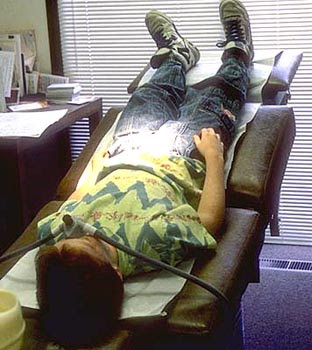Friday, December 11, 2009
61 - Trendelenburg position
*In the Trendelenburg position the body is laid flat on the back (supine position) with the feet higher than the head, in contrast to the reverse Trendelenburg position, where the body is tilted in the opposite direction.
*Trendelenburg position is a standard position used in abdominal and gynecological surgery.
*It allows better access to the pelvic organs as gravity pulls the intestines away from the pelvis.
*It was named after the German surgeon Friedrich Trendelenburg.
USES OF TRENDELENBURG POSITION :
- Hypotensive patients (patients with low blood pressure) have historically been placed in the Trendelenburg position in hopes of increasing their cerebral perfusion pressure (the blood pressure in the brain). A 2005 literature review found the "Literature on the position was scarce, lacked strength, and seemed to be guided by 'expert opinion.' A 2008 review however found adverse consequences to the use of the Trendelenburg position and recommended it be avoided.However, the passive leg raising test is a useful clinical guide to fluid resuscitation and can be used for effective autotransfusion.
- The Trendelenburg position used to be the standard first aid position for shock.
- The Trendelenburg position was used for injured scuba divers. Many experienced divers still believe this position is appropriate, but current scuba first aid professionals no longer advocate elevating the feet higher than the head. The Trendelenburg position in this case increases regurgitation and airway problems, causes the brain to swell, increases breathing difficulty, and has not been proven to be of any value. "Supine is fine" is a good, general rule for victims of submersion injuries unless they have fluid in the airway or are breathing, in which case they should be positioned on the side.
- Perhaps because of its effect on breathing difficulty and airway problems, the Trendelenburg position is used in waterboarding. (Waterboarding is a form of torture that consists of immobilizing the victim on his or her back with the head inclined downwards, and then pouring water over the face and into the breathing passages, causing the captive to believe he or she is dying.)
- The Trendelenburg position may be used in childbirth when a woman's cervix is too swollen and won't quite dilate to 10 centimeters, or during the incidence of a prolapsed umbilical cord to take pressure off the cord and get more oxygen to the fetus, or it can be used to help rotate a posterior fetus either during pregnancy or the birth itself.
- Trendelenburg position in helpful in surgical reduction of an abdominal hernia.
- The Trendelenburg position is also used when placing a Central Venous Line. Trendelenburg position uses gravity to assist in the filling and distension of the upper central veins when placing a central line in the internal jugular or subclavian veins. It is also used in the placement of a external jugular peripheral line for the same reason. It plays no role in the placement of a femoral central venous line.
-----------------------------------------------------------
*Look at this question from the schwartz's principles of surgery (8th edition) - Self-assessment and board review :
Q: The initial treatment of a patient with a suspected air embolism includes which of the following ?
a. Place the patient in a right lateral decubitus position
b. Immediate angiographic aspiration of air
c. Place the patient in a trendelenburg position
d. Immediate thoractomy with pump stand-by
Answer : C.
Explanation :
- Several complications occur with central access lines involving a venous line or a pulmonary artery line .
- One such dangerous complication is the AIR EMBOLISM.
- It is estimated to occur in 0.2 to 1% of patients .
- However when an air embolism does occur, the results often can be dramatic and mortality can reach 50%.
- Treatment may prove futile if the diagnosis is ignored, especially if the air embolism bolus is larger than 50 mL.
- Clinical auscultation over the precordium is often non-specific, so a portable chest X-ray is required if the patient can tolerate the procedure.
- Nonetheless, aspiration via a central venous line accessing the heart may assist in decreasing the volume of gas in the right side of heart, and minimize the amount traversing into the pulmonary circulation.
- Maneuvers to entrap the air in the right heart include placing the patient in the LEFT LATERAL DECUBITUS position and in TRENDELENBURG POSITION, so the entrapped air can then be aspirated or anatomically stabilized within the right ventricle.
- If the patient survives these initial maneuvers, then consideration should be given as to whether the patient goes to the operating room for controlled surgical removal of the air, or if an angiographic approach is undertaken.
- The advantage of the operative approach is that the resources needed to salvage the patient are more readily available in the operating suite, should there be an acute deterioration in the patient's condition.
Subscribe to:
Post Comments (Atom)

No comments:
Post a Comment